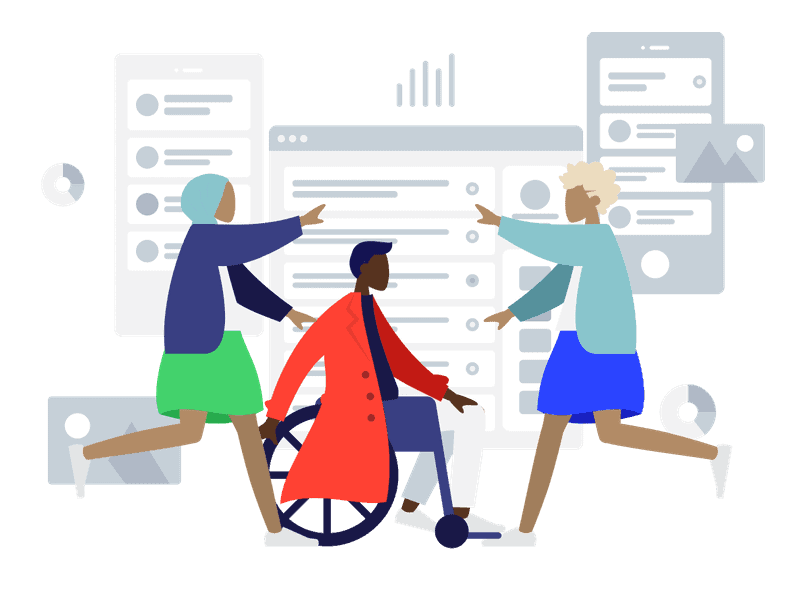Dans le paysage numérique d'aujourd'hui, il faut s'assurer que le contenu est accessible à tous les utilisateurs n'est pas seulement une question d'inclusion, mais aussi une obligation légale et éthique. Relever les défis de l'accessibilité permet aux personnes handicapées de s'engager dans le contenu numérique, ce qui favorise une expérience en ligne inclusive. En mettant en œuvre des solutions à ces problèmes, les entreprises et les créateurs de contenu peuvent élargir leur public, se conformer aux réglementations et promouvoir l'égalité d'accès pour tous. Dans cet article, nous allons explorer nos dix meilleures stratégies pour surmonter les défis courants en matière d'accessibilité et améliorer l'inclusion numérique.
Comprendre les défis de l'accessibilité
Les problèmes d'accessibilité font référence aux obstacles qui empêchent les personnes handicapées d'accéder pleinement au contenu numérique. Ces difficultés peuvent découler de déficiences visuelles, auditives, motrices ou cognitives. Par exemple, une personne souffrant d'une déficience visuelle peut avoir du mal à naviguer sur un site web dépourvu d'informations sur l'accessibilité. compatibilité avec les lecteurs d'écrantandis qu'une personne souffrant d'un handicap moteur peut avoir des difficultés à interagir avec un contenu nécessitant une navigation à l'aide de la souris uniquement. Le respect des normes établies, telles que la norme Lignes directrices sur l'accessibilité du contenu web (WCAG) et les Loi sur les Américains handicapés (ADA), est essentielle pour créer un contenu numérique accessible. En suivant ces lignes directrices, les créateurs de contenu peuvent éliminer les obstacles et s'assurer que leurs plateformes sont utilisables par tous.

Les 10 meilleures stratégies pour relever les défis les plus courants en matière d'accessibilité
Un langage clair et simple
L'utilisation d'un langage simple est une stratégie fondamentale en matière d'accessibilité. Un vocabulaire complexe, un jargon et des structures de phrases alambiquées peuvent rendre le contenu difficile à comprendre pour de nombreux utilisateurs, y compris ceux souffrant de handicaps cognitifs. Le contenu doit être rédigé dans un langage clair et simple, en utilisant des phrases courtes et des mots familiers. Cela permet de s'assurer que le message est compréhensible pour un large public, y compris pour les personnes dont ce n'est pas la langue maternelle ou qui ont des difficultés de lecture.
Utilisation correcte des titres
L'organisation du contenu avec des titres appropriés (H1, H2, H3, etc.) est essentielle pour la lisibilité et l'accessibilité. Les titres descriptifs aident à structurer le contenu, le rendant plus facile à parcourir et à comprendre pour tous les utilisateurs. Pour les utilisateurs qui utilisent des lecteurs d'écran, les titres constituent des repères de navigation qui leur permettent de passer rapidement d'une section à l'autre. Veiller à ce que les titres suivent un ordre logique contribue à créer une expérience homogène pour tous les utilisateurs.
Texte Alt pour les images
Texte alternatif (alt text) est un élément essentiel de l'accessibilité du web. Le texte alt fournit une description des images aux utilisateurs qui utilisent des lecteurs d'écran, ce qui leur permet de comprendre le contenu et le contexte de l'image. Lors de la rédaction du texte alt, il est important de transmettre l'objectif de l'image, plutôt que de simplement la décrire. Par exemple, au lieu de dire "image d'un chien", un texte alt plus informatif pourrait être "un chien d'aveugle aidant une personne à traverser un passage pour piétons".
Assurer le contraste des couleurs
Contraste des couleurs joue un rôle important dans la lisibilité du texte, en particulier pour les utilisateurs souffrant de déficiences visuelles ou de daltonisme. À la suite de la Taux de contraste recommandés par les WCAG Le rapport de contraste entre le texte et l'arrière-plan garantit la lisibilité du contenu pour tous. Par exemple, un rapport de contraste d'au moins 4,5:1 est requis pour un texte normal. Des outils en ligne peuvent vous aider à vérifier si vos schémas de couleurs respectent ces normes de contraste, ce qui est essentiel pour maintenir l'accessibilité.
Accessibilité du clavier
Tous les utilisateurs ne naviguent pas sur les sites web à l'aide d'une souris ; certains s'appuient sur la navigation au clavier en raison de handicaps physiques. Il est donc essentiel de veiller à ce que tous les éléments interactifs, tels que les liens, les boutons et les champs de formulaire, soient accessibles au clavier. Il s'agit notamment de permettre aux utilisateurs de naviguer dans un site à l'aide de la touche "Tab" et de veiller à ce que des indices visuels (tels que les états de mise au point) indiquent quel élément est actuellement sélectionné.
Formulaires accessibles
Les formulaires sont un élément clé de nombreux sites web, mais ils peuvent poser des problèmes importants aux utilisateurs handicapés. Afin d'améliorer accessibilité des formulairesIl est donc important d'étiqueter clairement chaque champ du formulaire et de fournir des instructions si nécessaire. En outre, les formulaires doivent être conçus pour fonctionner de manière transparente avec les lecteurs d'écran et autres technologies d'assistance. Par exemple, l'utilisation de "aria-labelsL'utilisation de l'expression " contexte " peut fournir un contexte supplémentaire aux champs de formulaire, garantissant que tous les utilisateurs peuvent les remplir avec précision.
Sous-titrage et transcription pour le multimédia
Vidéos et contenu audio sont de plus en plus courantes sur les sites web, mais elles peuvent être inaccessibles aux utilisateurs malentendants si elles ne sont pas accompagnées de sous-titres et de transcriptions. Les sous-titres offrent une alternative textuelle au contenu parlé des vidéos, tandis que les transcriptions fournissent une version textuelle complète du contenu audio. En outre, il est important de veiller à ce que les lecteurs multimédias eux-mêmes soient accessibles, en offrant des commandes qui peuvent être utilisées avec des technologies d'assistance.
Texte descriptif du lien
Le texte du lien doit toujours être descriptif et indiquer clairement la destination ou l'objectif du lien. Des phrases vagues telles que "cliquez ici" ou "en savoir plus" ne fournissent pas suffisamment d'informations aux utilisateurs qui utilisent des lecteurs d'écran. Optez plutôt pour un texte de lien descriptif tel que "En savoir plus sur nos services d'accessibilité". Ce texte fournit un contexte et permet à tous les utilisateurs de comprendre facilement l'objectif du lien.
Une navigation cohérente
Le maintien d'une structure de navigation cohérente sur l'ensemble de votre site web aide les utilisateurs, en particulier ceux qui souffrent de handicaps cognitifs ou moteurs, à naviguer plus facilement. Des étiquettes claires, des menus logiques et un placement cohérent des éléments de navigation permettent aux utilisateurs de se familiariser rapidement avec la structure de votre site. Cette cohérence réduit la confusion et augmente l'accessibilité globale de votre site.
Essais et validation
Enfin, il est essentiel de tester régulièrement l'accessibilité de votre contenu pour garantir le respect permanent des normes d'accessibilité. Les outils automatisés, tels que les lecteurs d'écran, les analyseurs de contraste de couleurs et les vérificateurs d'accessibilité, peuvent identifier de nombreux problèmes. Cependant, les tests manuels avec de vrais utilisateurs qui utilisent des technologies d'assistance sont tout aussi importants pour valider l'accessibilité de votre contenu dans des scénarios réels.

Outils et ressources pour l'accessibilité
Un large éventail d'outils est disponible pour aider à résoudre les problèmes d'accessibilité. Les lecteurs d'écran, tels que NVDA et JAWS, vous permettent de tester la compatibilité de votre contenu avec les utilisateurs malvoyants. Des outils tels que le WebAIM Contrast Checker garantissent que votre site web respecte les exigences des WCAG en matière de contraste des couleurs, ce qui améliore la lisibilité du texte. Les vérificateurs d'accessibilité, tels que WAVE et divers plugins tiers, fournissent des informations précieuses sur les problèmes potentiels, ce qui facilite le maintien de l'accessibilité de votre site. En outre, les produits Grackle tels que Balayage du gravelot, Stream, Workspace, et Accessibilité du support PDF des améliorations pour les formats web et documentaires.
Conclusion
Relever les défis de l'accessibilité est un processus continu qui exige de prêter attention aux détails et de s'engager en faveur de l'inclusion. En mettant en œuvre les stratégies décrites ci-dessus, vous pouvez vous assurer que votre contenu numérique est accessible à tous les utilisateurs. N'oubliez pas que la clé pour surmonter les obstacles à l'accessibilité est l'apprentissage, l'essai et l'amélioration continus. En prenant ces mesures, vous contribuez à créer un environnement numérique plus inclusif et plus équitable pour tous. S'il vous plaît contacter un membre de notre équipe aujourd'hui pour en savoir plus !



